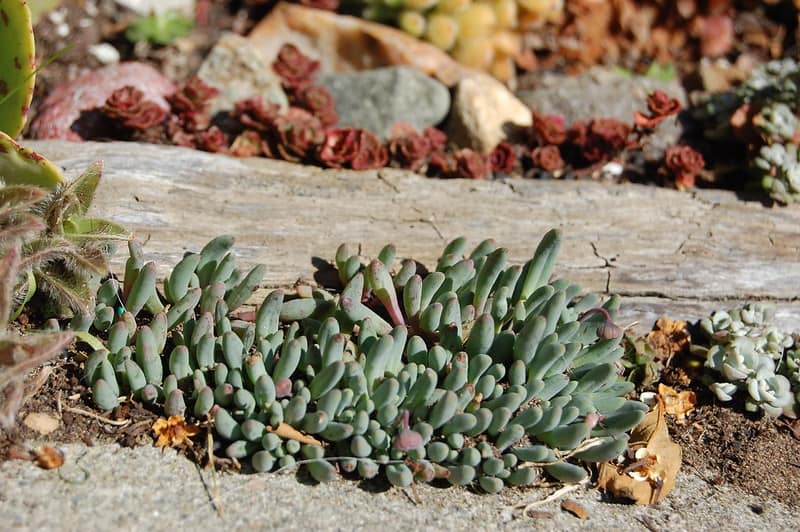If you are looking for a succulent that blooms, for a hanging basket, the Othonna capensis will be your plant.
Today we talk about their care and spread.
The Othonna capensis “Little Pickles” its flowers, its leaves and even its stems. You definitely have to add it to your collection of succulent pendants.
The Othonna capensis is also known as a ruby necklace.
It grows up to 2 inches (5 cm) tall, before continuing down.
This succulent gives us some beautiful yellow flowers similar to the Daisies.
Best of all, it blooms throughout the year. Its leaves look like beans and its stems are brightly colored.
When the plant is stressed, its leaves turn yellow, purple or red.
The ruby collar plant has become very popular as a cover.
Its low and rapid growth makes it ideal as a creeping plant.
Use the Othonna capensis in rock gardens, desert or baskets.
Characteristics
- Growth zone: USDA 9-10
- Height: 6 to 12 in. (15 – 30 cm)
- Yellow flower
- Flowering: All year
- Lighting: Full sun, filtered light.
- Use: Hanging baskets, pots, potscaping, stone and desert gardens. Minimum temperature: 50 ° F (10 ° C).
- Salt tolerance: From moderate to good.
Tips to take care of the Othonna capensis “Little Pickles”
The care of this succulent is different from others.
Illumination
For better flowering, the Othonna capensis should receive as much lighting as possible.
They can be in full sun or in a place where it receives filtered light.
In very warm places they can burn in full sun in the summer months. You must be aware.
Usually they require a soil with good drainage.
It can be slightly alkaline or acidic.
The seedling is very tolerant of poor soils as long as it drains well.
If you are going to grow it in a pot or basket, use substrate for cacti and succulents.
Irrigation
Unlike other succulents, the ruby necklace is not easy to drown.
He likes moderate humidity.
Do not wait for the floor to dry completely.
When the upper part dries again, water, this can be up to two to three times a week.
This succulent rests in the warm months. It is advisable to reduce irrigation and protect it from direct sun during these months.
In other words, let her rest in summer.
Pruning
Flower stems need to be removed to maintain their appearance.
These succulents tend to grow stretched mostly in pots and baskets.
Give it a good pruning at least once a year.
Fertilization
Fertilize them with a worm or compost humus once or twice a year.
Propagation
Take a cut of the plant and put it on a substrate for cacti and succulents.
Water them occasionally with a spray bottle.
When to transplant the Othonna capensis, transplant your succulent every 2 years.
Main Pest or Disease Problems On Othonna Plants
Othonna capensis is carefree and establishes itself quickly in almost any soil that provides sharp drainage. Poor drainage is sure to cause root rot and problems with disease.
Like most succulents, when kept as a houseplant Othonna is susceptible to standard pests that are common to succulents, such as:
- Spider mites
- Fungus gnats
- Mealybugs
- Scale
Follow “Best Practices”, such as:
- Keeping new plants in quarantine
- Avoiding overcrowding and overwatering
- Provide good ventilation
- Use appropriate insecticidal products as needed to keep these pests at bay.
Conclusion
This trailing succulent has a woody stem with small green leaves that look like pickles.
If happily stressed, the leaves turn a purplish red. Watch for yellow flowers in the Spring to Fall.
Othonna capensis “Little Pickles” is a great addition to rock gardens or hanging baskets. If grown in the ground, it spreads as it grows, creating ground cover. When grown in hanging baskets, it creates spectacular “spiller.”
